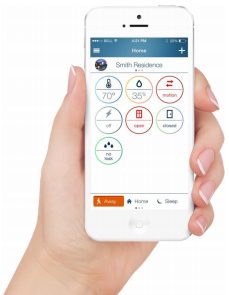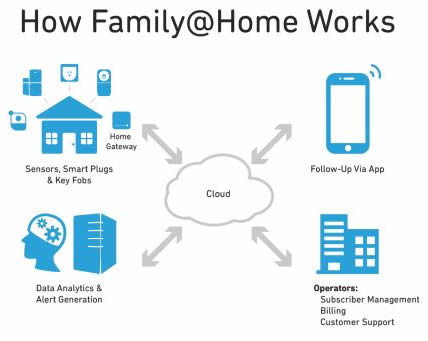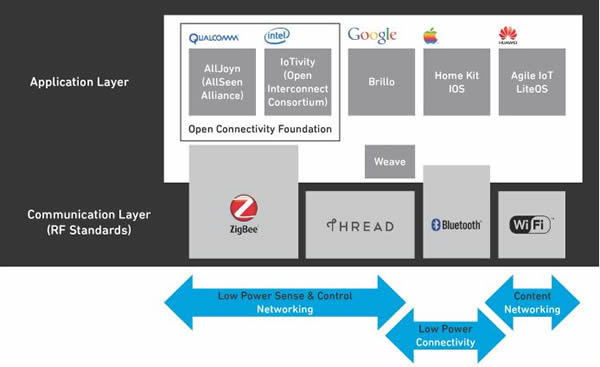What is SHaaS? And why should you care?
In April 2016, Comcast released an interesting report, compiled from almost 1,300 US consumers, providing valuable insight into why customers are interested in smart home services, what features they really want and how they plan to use smart home technologies. The findings are detailed in "The Safe & Smart Home: Security in the Smart Home Era", which can be downloaded below.
By Cees Links, GM of Qorvo Low Power Wireless, Formerly CEO and Founder of GreenPeak Technologies.
The big take-away from this report is that what consumers really want in the smart home is services – smart home as a service – not a bunch of connected devices that remotely control various widgets and devices in the home.
So What is Smart Home as a Service and How Does it Work?
First off, there is a big difference between a connected device and a smart device. Devices for the so called automated home have been around for decades. For many years, solutions have existed that allowed a hobbyist or home owner to remotely control the home’s doors, windows, environment, entertainment, etc. You (or your parents or grandparents) may remember the X10 communications protocol technology which was able to wirelessly control a wide range of in-home devices.
Many of today’s so-called smart home devices are basically slightly more sophisticated X10 systems. Instead of, or in addition to a local remote control, these devices can now be controlled over the internet by a smart phone. In fact, in some ways, these new devices may be even a bit less sophisticated than X10 because a single X10 controller could manage a variety of devices whereas many of today’s smart devices each require their own app running on the smart phone.
This means one app to control the home’s security, another for air conditioning and heating, and yet another for controlling the lighting. You get the picture; it is not pretty.
To convert a basic connected device to a smart device requires three additional capabilities.
One – it must be able to connect to and communicate with other smart or connected devices in the home. The security system needs to be able to exchange data and commands with the homes environmental controls (i.e. heating and air conditioning), leak detection, lighting, entertainment, lifestyle, etc.
Two – it needs to be intelligent. More than being able to be programmed to perform certain functions at certain times, a smart home solution needs to be able to recognize what is going on in a home, learn what is normal, and when something unexpected happens, take action and/or send an alert to the residents, proper authorities, caregivers or family members.
Three – all these functions need to be managed from a single application on a smart phone or any other web connected device such as a tablet. Currently, most connected devices and appliances offer their own app to manage and control operations. However, end users will not want to shuffle through a screen full of various apps in order to find out what is happening in their home.
As many of us already have cluttered up our smart phone screens with pages and pages of apps, it will be painful to add, configure and manage a handful of additional apps that do not share a common user interface or even common commands and logic.
Unified and Less Expensive
Unified SHaaS solutions can be more affordable than a bunch of connected devices. A SHaaS ecosystem can eliminate the overall number of sensors required, reducing redundancy and maintenance. A single sensor could be used for a variety of applications. For instance, a motion sensor could be used in a security system, for controlling lighting, for managing home environment, for controlling entertainment options, for family lifestyle, and maybe even for feeding the family pet.
Finally, in the battle going on with large technology companies regarding who will own the smart home and the Internet of Things, it makes it quite difficult for a consumer to decide which communication technology to use in their home. In addition to the commonly used and easily understood choice of Wi-Fi, Bluetooth and ZigBee, now the industry behemoths are introducing their own varieties of incompatible and competing smart home communication technologies. Not only does this make it overly complex for end-users, it is a challenge for the companies who actually develop and market the various hardware and software components destined for the smart home ecosystem.
If they guess wrong, and roll out a line of products based on an emerging standard that does not catch on, they could be wasting millions of dollars of development costs and years of development time.
Overview of Open and Proprietary Standard Activities
In addition to the available RF standards at the communication layer, there is a great deal of competition and fighting among the industry leaders at the application layer. This competition can make it challenging for service providers and device manufacturers to decide which wireless communications technology to adopt for the smart home solutions.
So What is the Solution? Smart Home as a Service, SHaaS
Instead of a consumer having to decide which hardware and software options to implement in their home, they can simply leave it up to the providers of home services. This includes the various operators who already provide internet access and entertainment to consumers and businesses worldwide. As these operators already have relationships with the home owner – their routers, modems, and set-top boxes are already in the home, and the customers are already accustomed to receiving and paying a monthly bill for these services.
However, the market for providing SHaaS is not limited to just the service providers and operators. Numerous retail organizations like Walmart, Home Depot, Costco, etc. who already provide a certain amount of home services, could easily enter this market sector, as well as various large security firms and integrators who could wrap up and market the entire suite of services and sell them as a unified package.
Insurance companies also see the benefits of smart home applications, when early warnings of water leaks, heating system defects, fire, etc. could help save huge amounts of money for repair, renovation and replacement.
By opting for SHaaS, consumers avoid the major challenges outlined above. They don’t need to be a technology genius. By having one organisation responsible for installation, set up and management, it makes it much faster to get the service up and running. In addition, if the home owner wants to add additional services like family lifestyle or leak detection, they just need to contact their service provider and they can get it installed, ready to be integrated and work with their existing service structure. A service provider can ensure that all the controls and user interfaces are unified – all the SHaaS options can live within a single dashboard – with common commands and look & feel. Finally, by providing an entire range of services, the consumer does not need to know or even care about what the underlying wireless connectivity technology is.
By providing an ecosystem of smart home services to millions of customers, the service providers themselves don’t have to worry as much regarding which connectivity technology wins the marketing war.
Finally, consumers want services. Numerous studies have indicated that aside from a few early innovators and hobbyists, most people want the benefits of a smart home without the challenge of actually investigating, purchasing, installing and maintaining a system of disparate connected devices. They want a system that simply works. You turn it on, you look at your smart phone’s customized smart home management app, and you can control and manage all aspects of what is going on the home. All from one app – one dashboard, not a collection of apps scattered across your smart phone’s screen.
How Does a SHaaS Application Actually Work?
One very sophisticated SHaaS application is family lifestyle monitoring. GreenPeak (now part of Qorvo) recently announced the Family@Home system that enables resident and parents to monitor what is happening in the house. However, it does a lot more. It is a smart system that can learn what is normal for the household and can take action if something out of the expected occurs, like the kids cutting school and coming home to have a party when the parents are not around.

The family lifestyle system uses sensors, connected devices, cloud intelligence and social media to combine a variety of important services into a simple to use app that enables service providers to make their customer’s lives easier and more secure.
SHaaS is like having a butler in your house, who can assist the family by turning off lights and the heating when nobody is in a room or locking back doors when that was forgotten. It is a collection of services that analyzes input from the smart home sensors, learns how the family lives and how the home is used, and can make intelligent decisions to make homes more comfortable, safer and more energy efficient.
Four Components in SHaaS
There are four basic components in a smart home as a service application like Qorvo’s Family@Home. First is a network of sensors in the home. This can be as few as four, depending on the size of the household – mounted in the bedroom and bathroom doorways, as well as in the kitchen and near the front door of the home. Comprised of either position or motion sensors, they can be used to provide a general indication of when and where movement usually occurs in the home. Additional motion and position sensors can provide additional data (i.e. position sensors on doors and windows can indicate whether the house is secure or not). Temperature sensors can help manage the environmental conditions in the home. Leak detectors mounted on appliances can provide early warning of plumbing issues. In addition, individuals in the home can use key fobs to register entering or leaving the house and provide their exact location and movements. Similar fobs can even be used on the family’s pets to keep track of their movements. Wearables with embedded sensors can be used to provide important information for monitoring of health and safety issues.
The information derived from these sensors is then wirelessly collected by a local hub (gateway, set-top box, etc.) and securely transmitted to an intelligent cloud service that collects and analyzes the data and then is able to generate alerts to family members, caregivers and first responders. After the initial installation of the Family@Home sensors linked to the analytics, it only takes a week or two for the algorithm in the cloud to accumulate enough data for the application to “learn” how the family lives and to be able to send alerts when an unexpected event happens or something drastically changes.
Another important component is the consumer’s management app, which can be accessed via a smart phone or any web connected device. The important consideration here is that all the various services need to be consolidated into a single user interface, into one easy-to-use dashboard where the home owner can monitor the state of their home as well as the people and pets inside.
Finally, the service provider is able to handle customer support, billing, subscriber management as well as software and service upgrades and changes.
These four components make the smart home as a service a reality. Not only is it easy to use, simple to manage, and effective in providing the residents with safety, security and comfort, it also serves as a valuable generator of income for the service providers.
Device and system developers need to work together to develop hardware, software and web intelligence to make this dream come true. Yes, this evolution is slow moving as most home owners do not consider major upgrades to their home technology until they decide to move into a new home. However, smart home as a service is the inevitable result. It is what home owners want. It is what service providers and retail businesses need to be successful in this new technology sector.
Two decades ago, automatic window control and door locking were expensive aftermarket add-ons in our cars. Nowadays, almost every car includes those features built in. A couple years ago, back up cameras and sonar were deluxe features, now almost every new car includes it. Decades from now, our children will look back at our “stupid, unconnected” homes, and wonder how we were able to live in such primitive conditions.
About the Author
Cees Links was the founder and CEO of GreenPeak Technologies, now part of Qorvo. Under his responsibility, the first wireless LANs were developed, ultimately becoming household technology integrated into PCs and notebooks. He also pioneered the development of access points, home networking routers, and hotspot base-stations. He was involved in the establishment of the IEEE 802.11 standardisation committee and the WiFi Alliance. He was also instrumental in establishing the IEEE 802.15 standardization committee to become the basis for the ZigBee sense and control networking. Since GreenPeak was acquired by Qorvo, Cees has become the General Manager of the Low Power Wireless Business Unit in Qorvo.











